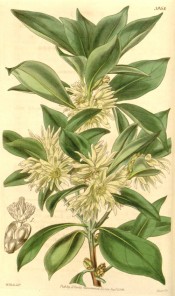Illicium anisatum L.
Frost hardy, conical evergreen shrub or small tree with glossy, lance-shaped leaves, to 12cm, and fragrant, star-shaped, yellow-green, later cream, flowers, to 2.5cm across, in spring. To 8m. [RHSE, Hortus, Hilliers’].
Horticultural & Botanical History
Illicium religiosum was introduced to Holland from Japan by Dr. Siebold, a plant being presented to Kew by Mr. Makoy of Liege, first flowering in 1842. ‘I am not aware that the sacred Aniseed Tree of the Japanese has ever been cultivated in Europe, till it was lately introduced into Holland by the distinguished Japanese Traveller and Botanist, Dr. Siebold. We are indebted to Mr. Makoy of Liege for a fine young plant, which he presented to the Royal Botanic Gardens at Kew, and which flowered in great perfection in the greenhouse in March, 1842. Dr. Siebold has determined that there are two species, one the I. Anisatum of Loureiro, the Chinese kind; and the other that here figured, the “Fanna Skimmi Fanna, i.e. Flos dicta,” of Kaempfer’s Amaenitates Exotica. It would appear that the two have been confounded by most authors, and that Loureiro’s name of anisatum has been incorrectly given to the Japan kind. By the Japanese this plant is held sacred; they strew wreaths of it and branches over the tombs of their friends, and their priests burn the bark as a perfume upon the altars of their deities. A singular use is made of the pulverized bark by the public watchmen. Hollow tubes, graduated on the outside, are filled with this substance, which is lighted at one extremity, and burns gradually and uniformly: so that when the fire has reached a certain mark, the watchmen strike the hour upon a bell, and thus announce it to the public.’ [BM t.3965/1842]. It was introduced as Illicium anisatum as early as 1790 from China. [Don, Hilliers’].
History at Camden Park
Listed in all published catalogues [T.570/1843]. Received per ‘Sovereign’ February 1831 [MP A2948]. The Japanese Star Anise, Illicium anisatum L., and the common Asian spice Star Anise, or Chinese Star Anise, Illicium verum Hook.f., are frequently confused in the literature. Although the trees are very similar in appearance the former is very toxic and not a substitute for the true Star Anise. Macarthur identifies his plant as the Aniseed tree so it is possible that he was referring to Illicium verum Hook.f. rather than Illicium anisatum as specified. Macarthur’s plant cannot have been the Illicium religiosum of Curtis’s Botanical Magazine.
Notes
Illicium anisatum Bartr. ex Michx. (1803) = Illicium parviflorum Michx.
Published Mar 18, 2009 - 05:22 PM | Last updated Jul 22, 2010 - 05:25 PM
| Family | Illiciaceae |
|---|---|
| Category | |
| Region of origin | East Asia |
| Synonyms |
|
| Common Name | Japanese Star Anise |
| Name in the Camden Park Record | Illicium anisatum - Aniseed tree |
| Confidence level | medium |


